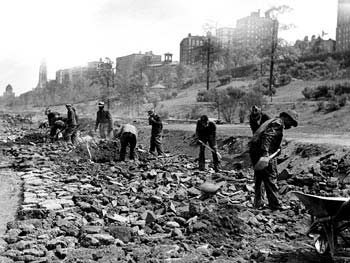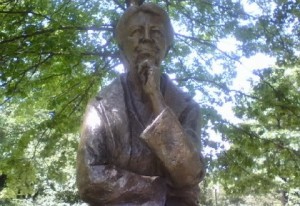As a longtime resident of New York City, it was difficult for me to pick a favorite New Deal site, as there so many possibilities. I was tempted to choose Orchard Beach, in the Bronx, where my father learned to swim in the 1930s, or the former U.S. Customs House (now the National Museum of the American Indian), with its magnificent, Reginal Marsh murals, one of which adorns the Living New Deal’s wonderful map-and-guide to public works and art in New York. But I had to settle on Riverside Park. The park was originally designed by Frederick Law Olmsted. and Calvert Vaux in the 1860s, but by the Great Depression it remained “a vast low-lying mass of dirt and mud,” in the author Robert Caro’s description, with an open railroad line and homeless encampments considered so dangerous that the police would not approach them.
Many schemes had been floated to transform the park, but not even the powerful parks commissioner Robert Moses could get it done before PWA and CWA funds were made available. The result was a 6.7-mile-long strip of leafy grandeur along Manhattan’s Upper West Side that covered the railroad, and added a highway, a boat basin, an amphitheater, numerous playgrounds, biking and running trails, benches, tennis courts, ballfields benches, and countless trees.
While praising Riverside as “unprecedented in urban America,” Caro also criticized it for favoring cars over people and—infinitely worse—neglecting its Harlem stretches due to Moses’ inveterate racism. This was true—but like so much of the New Deal, “the West Side Improvement” built a foundation that could be improved on. In the years since, numerous playgrounds and other public spaces have been added to Riverside’s Harlem blocks, and the park has also been extended southward, from 72nd down to 59th St. It is a terrific place to exercise, picnic, stroll or simply stare at the Hudson River flowing by. I am taken anew by its beauty every time I go there.
— Kevin Baker


